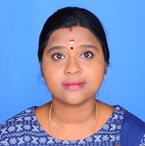Invited Speaker----Dr. Saranya Kuppusamy

DST-SERB Ramanujan Fellow, Centre for Environmental Studies, Anna University, India
Dr. Saranya Kuppusamy received B.Sc. degree (Agriculture) from Tamil Nadu Agricultural University (TNAU), Coimbatore, India in 2009, and the M.Sc. degree (Agricultural Microbiology) from TNAU in 2011. She received her PhD degree (Environmental Remediation and Public Health) from the University of South Australia, Adelaide, Australia in 2015. Dr. Saranya Kuppusamy was the recipient of the prestigious International Postgraduate Research Scholarship and the Cooperative Research Centre for Contamination Assessment and Remediation of the Environment (CRC CARE) top-up fellowship offered by the Australian government, University of South Australia and CRC CARE (2012-2015). She joined the Gyeongsang National University, Jinju, South Korea in Nov. 2015 and worked there as a Research Professor until June 2018. Dr. Saranya Kuppusamy returned back to India in July 2018 after receiving the prestigious Ramanujan fellowship from the Government of India. From Aug. 2018 to current, she is based at the Centre for Environmental Studies, Anna University as a DST-SERB (Department of Science and Technology – Science and Engineering Research Board, Government of India) Ramanujan Fellow (Scientist-D) and is the principal investigator of a DST-SERB funded project that explores antibiotics resistance in the environment.
Dr. Saranya Kuppusamy specializes in different areas of agriculture and environment (soil chemistry, fertility and management; environmental biotechnology; biochar; soil and water remediation; waste management; crop quality improvement) and has authored about 48 peer-reviewed, high impact publications (Total impact factor: 114.8; Total citations: 824) that include 45 journal articles, 2 book chapters, and a book, with 11 international conference proceedings. She had received the excellent thesis presentation award from the Korean Society of Environmental Agriculture (KSEA) in 2016 International Symposium and Annual Meeting of KSEA held at Muju, South Korea. She had also received a best poster award from the Korean Society of Soil Science and Fertilizer (KSSF) in the 2016 International Symposium and Annual Meeting of the KSSF held at Seoul, South Korea.
Speech Title: Quercus robur acorn peel as a low-cost adsorbent for hexavalent chromium removal from aquatic ecosystems and industrial effluents
Abstract: The efficiency of low-cost, abundantly available local forestry waste, oak (Quercus robur) acorn peel (OP), to remove toxic Cr(VI) from aqueous solutions was studied in a batch system as a function of contact time, adsorbate concentration, adsorbent dosage and pH. In an equilibrium time of 420 min, the maximum Cr removal by OP at pH 2 and 10 was 100 and 97%, respectively. The sorption data fitted well with Langmuir adsorption model. Evaluation using Langmuir expression presented a monolayer sorption capacity of 47.39 mg g-1 with an equilibrium sorbent dose of 5 g L-1 and pH 7. Uptake of Cr by OP was described by pseudo-second-order chemisorption model. ICP-OES, LC-ICPMS analysis of the aqueous and solid phases revealed that the mechanism of Cr(VI) removal is by ‘integrated adsorption and reduction’ mechanism. ESEM-EDX and XRD analysis of OP before and after adsorption also confirmed that both adsorption and reduction of Cr(VI) to less toxic Cr3+ forms followed by complexation onto the adsorbent surface contributed to the removal of Cr(VI). Consistent with batch studies, OP effectively removed (>95%) Cr from the real water samples collected from lake and sea. The results of this study illustrate that OP could be an economical, green and effective biomaterial for Cr(VI) removal from natural aquatic ecosystems and industrial effluents.



